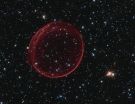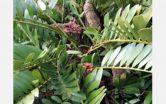A protein called cFLIP makes tumor cells in breast cancer resistant to treatments
2010-12-15
(Press-News.org) Researchers at the Andalusian Institute for Molecular Biology and Regenerative Medicine (CABIMER) and the University of Granada found that cFLIP –an inhibitor of death ligand-induced apoptosis– is not only essential in breast tumor cells resistance to TRAIL treatments (a death ligand with a potent therapeutic potential against cancer), but this protein is also key to the survival of such cancer cells.
Researchers proved that a variation in the expression of this protein may lead to the normal development of breast epithelium. This is an important finding to be considered in the design of cFLIP-targeted therapies against cancer.
The research conducted by Rosario Yerbes Cadenas, PhD candidate at the University of Granada, was led by professor Abelardo López Rivas, of CABIMER, and was aimed at analysing the potential of cFLIP inhibitors in cancer therapies.
At present, TRAIL is a death-ligand of the TNF family, with significant therapeutic potential against cancer, basically due to its ability to induce apoptosis in cancer cells without displaying significant toxicity toward normal cells. However, there are tumor cells that are resistant to TRAIL-induced apoptosis for unknown causes.
A Key Component
This study analysed the role of cFLIP in breast cancer cells' resistance to TRAIL-induced apoptosis. Thus, researchers concluded that cFLIP is key in these cells' resistance to TRAIL. Such conclusion was drawn from the evidence that the inhibition of their expression through treatments with Doxorubicin (anthracycline, widely used in chemotherapy) or with SAHA (Histone deacetylases inhibitor), as well as the silencing of its expression through cFLIP siRNA oligos (small interfering RNA), resulted in the sensitisation of breast cancer cells to TRAIL-induced apoptosis.
The authors of this research proved that cFLIP plays a survival role in tumorous and non-tumorous breast epithelial cells, since the inhibition of its expression induces apoptosis. This type of apoptosis requires the formation of the death-inducing signalling complex, which includes TRAIL-R2 receptor, adapter molecule FADD and procaspase-8- but is TRAIL-independent itself.
Conversely, in the light of the cFLIP relevance in controlling apoptosis, researchers studied the role of cFLIP in breast epithelial cells MCF-10A morphogenesis -a process where apoptosis plays an essential role. Thus, cFLIPL/cFLIPS overexpression inhibits lumen formation in acini from breast epithelial cells when they are cultured in a 3D extracellular matrix (3D cultures). Additionally, inhibition of cFLIP expression prevents the development of acini, since cells with low expression of cFLIP are unfeasible.
For this reason, regulation of cFLIP expression was very relevant to this research. Scientists determined that the PI3K/AKT signalling pathway is not the main responsible for cFLIP synthesis in breast cancer cell, but may be it is NF-kB pathway.
Additionally, this study revealed that the ubiquitin-proteasome system plays a key role in cFLIP cell degradation. At present, researchers are trying to identify E3-ubiquitin ligase protein, responsible for cFLIP degradation by such system.
INFORMATION:
References:
Flavopiridol induces cFLIP degradation by the proteasome and promotes TRAIL-induced early signal transduction and apoptosis in breast tumor cells. Carmen Palacios, Rosario Yerbes and Abelardo López-Rivas. Cancer Research, 2006
Roscovitine sensitizes breast cancer cells to TRAIL-induced apoptosis through a pleiotropic mechanism. Ortiz-Ferrón G, Yerbes R, Eramo A, López-Pérez AI, De Maria R, López-Rivas A. Cell Research, 2008
Cellular cFLIPL plays a survival role and regulates morphogenensis in breast epithelial cells. Yerbes R., Palacios C, Reginato MJ. and López-Rivas A. The Journal of Biological Chemistry (en revisión).
Contact: Rosario Yerbes Cadenas. CABIMER. Office phone number: +34 954467934. E-mail: Rosario.yerbes@cabimer.es
Accessible on English version
Accesible en Versión española
Accessible sur le site Version française
ELSE PRESS RELEASES FROM THIS DATE:
2010-12-15
The delicate shell, photographed by the NASA/ESA Hubble Space Telescope, appears to float serenely in the depths of space, but this apparent calm hides an inner turmoil. The gaseous envelope formed as the expanding blast wave and ejected material from a supernova tore through the nearby interstellar medium. Called SNR B0509-67.5 (or SNR 0509 for short), the bubble is the visible remnant of a powerful stellar explosion in the Large Magellanic Cloud (LMC), a small galaxy about 160 000 light-years from Earth.
Ripples seen in the shell's surface may be caused either by subtle ...
2010-12-15
From southern Africa's pineapple lily to Western Australia's swamp bottlebrush, flowering plants are everywhere. Also called angiosperms, they make up 90 percent of all land-based, plant life.
New research published this week in the Proceedings of the National Academy of Sciences provides new insights into their genetic origin, an evolutionary innovation that quickly gave rise to many diverse flowering plants more than 130 million years ago. Moreover, a flower with genetic programming similar to a water lily may have started it all.
"Water lilies and avocado flowers ...
2010-12-15
A case study from the Swedish medical university Karolinska Institutet sheds light on the pathological course of Alzheimer's disease. The brain of the first Alzheimer's patient to display amyloids demonstrable with a PET scanner has been studied, both during progression of the disease and after death.
One pathological characteristic of Alzheimer's disease is the accumulation in the brain of beta-amyloid proteins to form amyloid plaques. However, it is not known how early the plaques forms in the brain, whether they are the primary cause of the disease or what pathogenic ...
2010-12-15
How depressed young people are strongly predicts how aggressive and violent they may be or may become. Contrary to popular belief, however, exposure to violence in video games or on television is not related to serious acts of youth aggression or violence among Hispanics in the US, according to new research by Dr. Christopher Ferguson from Texas A&M International University. His findings are published online in Springer's Journal of Youth and Adolescence.
The potential negative effects of violent video games on adolescent antisocial behavior, and youth violence in particular, ...
2010-12-15
Washington, DC, December 14, 2010—Perceived ethnic discrimination among Mexican and Mexican American students from Phoenix-area middle schools places them at risk for increased stress when trying to acculturate with mainstream U.S. culture, according to a new study. As the students experienced acculturation stress related to discrimination, they were at a higher risk for alcohol, cigarettes, and marijuana use. The study is in the December issue of Prevention Science, a peer-reviewed journal of the Society for Prevention Research.
"As levels of perceived discrimination ...
2010-12-15
Hawaiians can now worry less about finding stray yellowjackets living in their Christmas trees shipped from the mainland United States, partly due to research by a U.S. Department of Agriculture (USDA) scientist and his university and state cooperators.
Every year, fir trees from the Pacific Northwest are shipped to Hawaii for use as Christmas trees. Although yellowjackets usually nest in the ground, mated queens who haven't yet built their nests sometimes make fir trees their home during winter. So, when the trees are harvested in November for shipment to Hawaii, the ...
2010-12-15
DURHAM, N.H. –- A team of scientists led by Marc Lessard of the University of New Hampshire Space Science Center launched an instrument-laden, four-stage sounding rocket from Norway's Andøya Rocket Range into aurora about 200 miles above Earth early Sunday morning (Dec. 12, 2010), just before the two-week launch window slammed shut. For the 10-minute flight, a 65-foot-long Black Brant XII rocket arced through a funnel-shaped region of Earth's magnetic field lines before landing some 900 miles downrange in the Norwegian Sea. The science data were transmitted to a ground ...
2010-12-15
New York, NY, December 14, 2010 – Inhaled corticosteroids are widely used in the treatment of asthma and chronic obstructive pulmonary disease (COPD). However, these drugs may be associated with diabetes development and progression. In a study published in the most recent issue of The American Journal of Medicine, researchers found that inhaled corticosteroids were associated with a 34% increase in the rate of diabetes onset and in the rate of diabetes progression. At the highest inhaled doses the risk increased by 64% in diabetes onset and 54% in diabetes progression.
Although ...
2010-12-15
If you're unsure about what foods to eat to maintain a healthy diet, you're not alone. Increasing evidence continues to point people back to basics – and reach for the milk. A study to be published in the January edition of American Journal of Clinical Nutrition reveals that drinking three glasses of milk per day may lead to an 18% decreased risk of cardiovascular disease.
The research conducted at Wageningen and Harvard Universities, examined 17 studies from Europe, USA and Japan, also found no link between the consumption of regular or low-fat dairy and any increased ...
2010-12-15
Children in Sweden are exposed to a huge number of TV advertisements. Food adverts – primarily for fast food and sweets – dominate the advertisements shown during children's viewing times. Research from the University of Gothenburg, Sweden, shows that Sweden is no different from other countries when it comes to the number of adverts that children are exposed to.
Children between the age of three and 12 in Sweden encounter an average of 50 or so TV advertisements for food a week, dominated (in descending order) by fast food, alcohol, chocolate and sweets. The results were ...
LAST 30 PRESS RELEASES:
[Press-News.org] A protein called cFLIP makes tumor cells in breast cancer resistant to treatments


